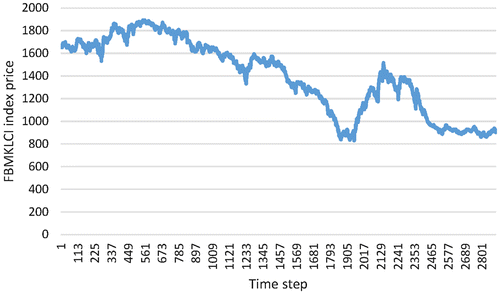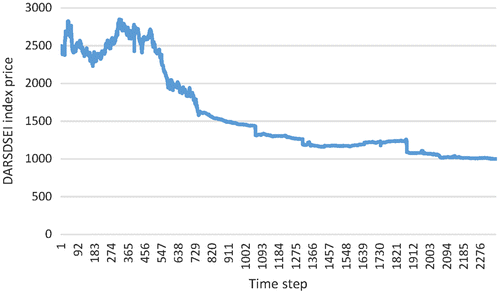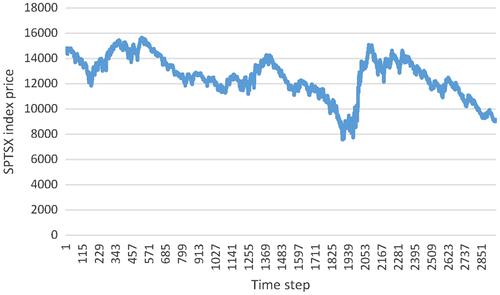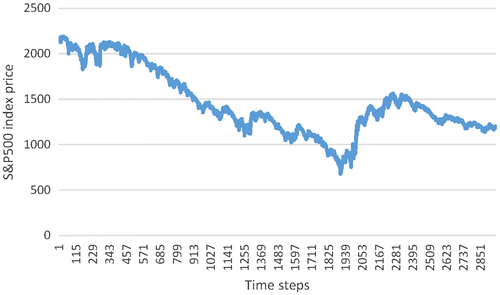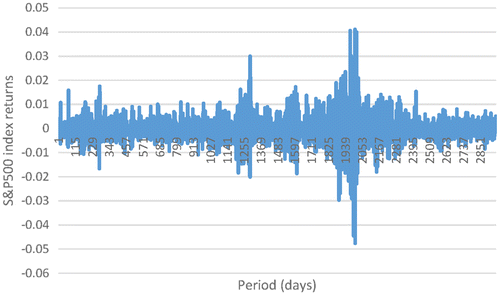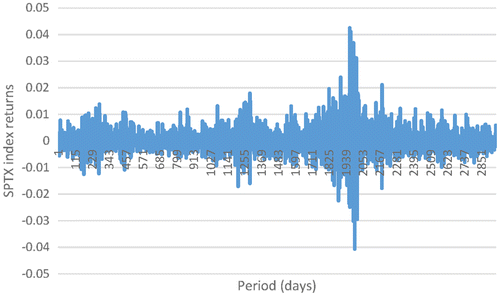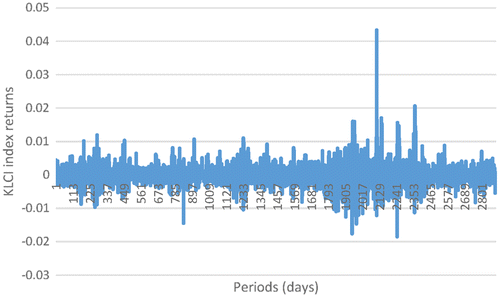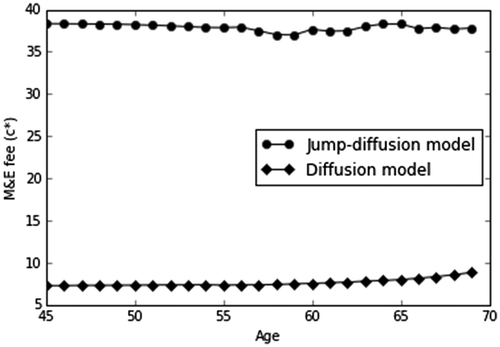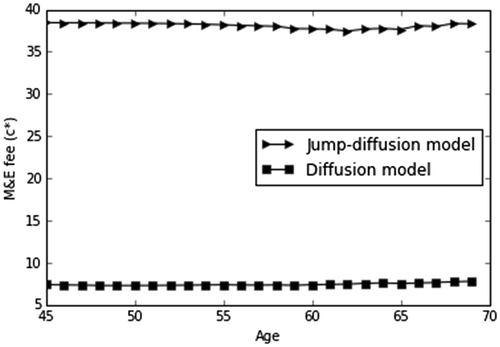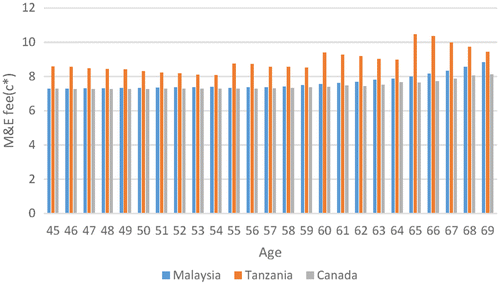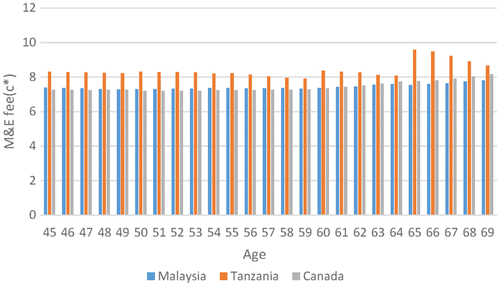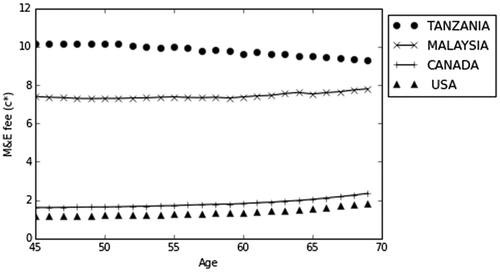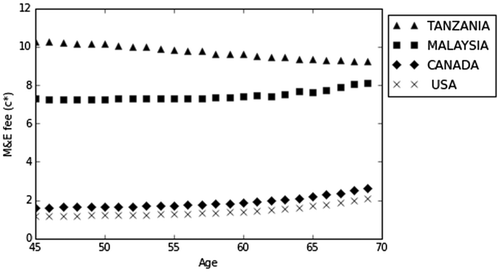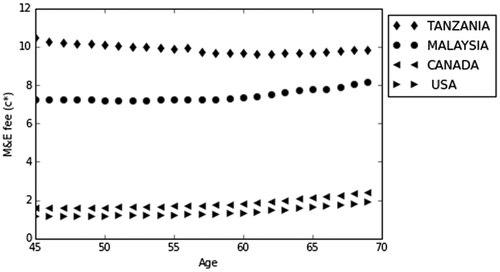 ?Mathematical formulae have been encoded as MathML and are displayed in this HTML version using MathJax in order to improve their display. Uncheck the box to turn MathJax off. This feature requires Javascript. Click on a formula to zoom.
?Mathematical formulae have been encoded as MathML and are displayed in this HTML version using MathJax in order to improve their display. Uncheck the box to turn MathJax off. This feature requires Javascript. Click on a formula to zoom.Abstract
Financial crisis in 2007–2008 have caused losses to life insurance companies issuing variable annuities with guarantees. This is partly due to failure of variable annuity (VA) issuers to anticipate the large variations in asset prices during the financial crisis times in their pricing framework and also setting a higher guaranteed rate. This study aims to investigate the pricing of the guaranteed minimum death and accumulation benefits embedded in flexible premium VA. We compare the prices from calibrated Black–Scholes model to that of calibrated jump-diffusion model. Although both models assume constant volatility, the fact that Black–Scholes model ignores abnormal asset price changes due to jumps is likely to under-price the VA. We also conduct a case study to analyse the impact on guarantee fees for different stock market performance and regional mortality rates.
Keywords:
Public Interest Statement
This study investigates the pricing of the guaranteed minimum benefits embedded in variable annuity (VA). Financial crisis in 2007–2008 have caused losses to life insurance companies issuing variable annuities with guarantees. The study assesses the effects of jumps in the asset price process on the VA guarantee fees. We also analyse the impact on the guarantee fees from stock market performance and regional mortality rates. The study confirms that by ignoring jumps in the asset price, Black–Scholes model leads to under-pricing of the VA guarantees. This implies that Life Insurance Company has a high probability of suffering losses due to abnormal asset price changes if it uses Black–Scholes model in pricing. Also the study shows that high-performing stock markets reduces the cost of the VA guarantees, while higher mortality rates of annuitants increase the cost of the VA guarantees.
1. Introduction
A variable annuity (VA) is an agreement between the life insurance company and the annuitant for the writer to pay periodical income in exchange for premium payment from the holder. They are of two types according to premium payment: single premium variable annuity (SPVA) and flexible premium variable annuity (FPVA). FPVA is a VA with periodical premium payments or instalment during the deferred period or accumulation period (Bernard, Cui, & Vanduffel, Citation2016; Chi & Lin, Citation2012). The policyholder makes many payments during the life of the policy (Costabile, Citation2013). The periodical payment can be constant, increasing or decreasing. In SPVA only one payment is paid during inception. VAs are known by various names like segregated funds (Canada) and Unit- or equity- or fund-linked (UK).
The investments of the VAs are in mutual funds. Equity-linked life insurance products enable the annuitants’ contributions to be invested in equity market. This means that the returns on investments are directly linked to a particular equity fund of the annuitants’ choice. Upon selection, the premiums are transferred to a third-party fund manager by the insurer. Alternatively the investments can be linked to the performance of an index rather than a stock, in this case they are known as Equity-Indexed Annuities or simply Indexed Annuities (EIA) rather than Equity-Linked or Unit-Linked Annuities (ELA).
VAs have embedded options which provide protection against the downside of the stock market performance (during the bear market, poor performance and investment during the bull market, good performance) and outliving the annuitant`s income due to longevity risk. The embedded options include guaranteed minimum death benefits (GMDB) and guaranteed living benefits (GLB). GLB comprise guaranteed minimum income benefits (GMIB), guaranteed minimum accumulation benefits (GMAB), guaranteed minimum withdrawal benefits (GMWB) and guaranteed lifetime withdrawal benefits (GLWB). For detailed explanation please refer to (Hardy, Citation2003; Stone, Citation2003). Many studies on evaluation of guarantees are based on guarantees embedded in SPVA (Bacinello, Millossovich, Olivieri, & Pitacco, Citation2011; Milevsky & Posner, Citation2001). The implication of the SPVA is that it is mainly meant for adults in their 50s and above who have earned enough from their work to make only one payment (Bacinello, Millossovich, Olivieri, & Pitacco, Citation2012; Bauer, Kling, & Russ, Citation2008).
Insurance companies charge a fee to fund the guarantees. The fee is known as mortality and expense fee (M&E fee) or insurance risk charges or insurance fees. If the fees are too high relative to the fund performance, the annuitant can terminate or surrender the guarantee and if the fee are too low relative to the fund performance then the life insurance company stands to suffer losses. Hence the fee should be fair.
Many writers of VAs suffered losses during the global financial crisis of 2007–2008 and other crisis which affected specific regions in previous times. Equitable life UK is an example of failure to incorporate jumps in the asset prices and time-varying volatility in pricing of the guarantee. The Company guaranteed a very high guaranteed rate when inflation was high in the early 1970s. After decades of operations, the economic changes slowed down the inflation. This caused the Company to suffer losses and forced to close for new business by December 2000. Fluctuation of asset prices in such times becomes high which made the value of the guarantees more expensive than previously calculated.
Many literature use Black–Scholes model to price the guarantees embedded in VAs. Black–Scholes approach assumes a geometric Brownian motion (GBM) for the asset price which fails to reflect the leptokurtic distribution of asset returns, the volatility smiles and the variation of asset returns due to abnormal changes in asset price or jumps in the price process (Merton, Citation1976). Because of their long-term nature and importance to the retirees, it is necessary for the writers to incorporate volatility smiles in their evaluation. It has been shown that deterministic volatility including the constant volatility models does not take into account the fat tails and volatility smile behaviours of the asset returns.
Many studies have been done to improve the Black–Scholes model. They include:
| • | Incorporating jumps in the price process assuming constant volatility as in BS model (Hanson & Westman, Citation2002; Kou, Citation2002; Merton, Citation1976). | ||||
| • | Assuming a constant elasticity of variance (Cox & Ross, Citation1976). | ||||
| • | Assuming a stochastic volatility without jumps in the asset price process (Amin & Ng, Citation1993; Heston, Citation1993; Hull & White, Citation1987; Stein & Stein, Citation1991). | ||||
| • | Assuming a stochastic volatility and jumps in the asset price dynamics (Bates, Citation1996; Scott, Citation1997). | ||||
Black–Scholes model ignores the jumps in the asset prices caused by over or under reaction due to good or bad news coming from the market or an individual company. Hence it doesn’t consider the impact of information arrival on the asset price changes. It only considers normal asset price changes but not abnormal.
By assuming the impact of market or company news arrival in specific discrete times which are random (jumps in asset prices), the GBM of the Black–Scholes model is transformed into a leptokurtic distribution with volatility smiles. Jump models have better analytical tractability than stochastic volatility models specifically for path-dependent options. They capture short-term characteristics or behaviour of the financial market better than stochastic volatility models (Yan & Hanson, Citation2006). In other words, they handle short-term smiles better.
The plots of time series of the market data whether market index prices, refer Figures – or individual company price movements show such presence of jumps. Also plots of times series of the asset returns whether market index returns, refer Figures – or individual company returns depict the presence of upward and downward jumps. Figures – shows the stock market index price movements for the Tanzania, Malaysia, Canada and USA markets and their corresponding stock market index returns are shown in Figures – for the dates 1 January 2005–1 October 2016. Good news from the market or individual company causes upward jumps, while bad news causes downward jumps. Big and very big downward jumps relate to financial crisis and cause the financial market to crash. Big downward jumps in history include 1987, 2000–2002 and 2007–2008. In their papers, Kou (Citation2002, Citation2007) showed that the addition of jump in the Black–Scholes model generates high peak (under-reaction) in the asset return leptokurtic distribution and heavy tails (over-reaction). In his paper, Merton (Citation1976) assumed that the extra randomness of the underlying asset price due to jumps can be diversified away. By modelling jumps, the smiles can better be fitted.
Because of the 2007–2008 financial crisis and the previous 1987, 2000–2002 we intend to investigate whether a Black–Scholes model is appropriate to calculate the M&E fee for the combined guaranteed minimum death and accumulation benefits (GMDB&GMAB) embedded in a FPVA in such times of financial crashes. We hypothesize that the financial crisis in that period was due to jumps in the asset prices, especially downward jumps, caused by abnormal changes in the asset prices. We use stock market indices from 2005 to 2016 (which includes one of the global financial crisis period) to calibrate the jump-diffusion model and the diffusion model. Then we conduct a case study to determine the impact of investing into various stock markets by the life insurance company writing VAs on the M\&E fees and the impact of regional mortality differences on the combined guarantees fees when the VA writer issues the product to annuitants of different regions (countries).
The study seeks to address the following questions:
| • | What is the impact of jumps in the underlying asset price process on the guarantee fees? | ||||
| • | Will the insurance company charge the same price when the premium is invested in a foreign stock market as in a local stock market? | ||||
| • | Will the insurer charge the local policyholder same price as the foreign policyholder when the insurer issues the VA to both local and foreign annuitants? | ||||
The contribution of the study is three fold:
| • | To evaluate the impacts of jumps in the underlying asset price process on the guarantees fees. | ||||
| • | To analyse the impact of investment in a foreign stock market on the costs of GMDB and GMAB embedded in FPVA. | ||||
| • | To assess and evaluate the impacts of entering a foreign VA market on the price of the GMDB and GMAB embedded in FPVA. | ||||
The organization of the remaining part of the paper is as follows: section two explains the methodology while section three addresses the results and discussion of the findings. Section four concludes the study.
2. Methodology
In this section we outline the models used and the experiments conducted under different cases, we explain the data used and the calibration procedure of the diffusion and jump-diffusion models.
2.1. Underlying asset price dynamics
We propose a new model, jump-diffusion model, which takes into account the large, infrequent and abnormal variations of asset price caused by market news arrival in addition to normal changes of asset price due to disequilibrium in market demand and supply. We extend the work of Milevsky and Posner (Citation2001) by allowing jumps in the underlying asset price process.
Compared to Black–Scholes model which considers only normal asset price changes, jump-diffusion model considers both normal and abnormal asset price changes and hence makes it a better model. Different from stochastic volatility models, jump-diffusion models have better analytical tractability specifically for path-dependent options and capture short term characteristics or behaviour of the financial market better (Yan & Hanson, Citation2006). In other words, they handle short-term smiles better.
We evaluate the guarantee fees using this proposed model and compare to the fees evaluated using the Black–Scholes model which only considers risk to the life insurer brought by normal changes of asset price caused by the imbalance of market demand and supply.
In the proposed new model, jump-diffusion model, the value of an asset at time t, (St) follows a GBM and a jump process outlined by Poisson process, Nt. The asset price follows GBM between jumps.(1)
(1)
where Nt is a Poisson process with an intensity of λ given by:(2)
(2)
St is the asset price at time t, Bt is a standard Brownian motion, J (is a function which causes a jump of stock price) is the jump size or magnitude which are i.i.d r.vs. The study by Merton (Citation1976) considers the case where the jump sizes are normally distributed (J~N (μ, σ)).
Under the Black–Scholes model, the dynamics of the stock price (St) follows a GBM and is given by the following SDE:(3)
(3)
2.2. Account value dynamics
At and c are denoted as the sub account value at time t and the M&E fee payable continuously, respectively, and k is the subsequent contributions. Under the Black–Scholes model assumptions, the sub account is given by:(4)
(4)
While in the proposed jump-diffusion model assumptions, the sub account is given by:(5)
(5)
(6)
(6)
2.3. Guarantee benefits dynamics
The study considers combined guaranteed minimum death and accumulation benefits (GMDB&GMAB) with roll-up premiums. A pre-agreed guaranteed interest rate g ≥ 0 is chosen in such a way that g < r. The guarantee benefit, Gt, is given by:(7)
(7)
The guarantee benefits considered resemble the arithmetic Asian put option where the account value, At, becomes the underlying asset. Their pay-off function, P(t), is given by:(8)
(8)
2.4. Guarantee benefits evaluation
Cash outflow less cash inflow constitutes the guarantee benefits loss function. The cash outflow is composed of the GMAB and GMDB pay-out and cash inflow is comprised of the guarantee benefits fee (Stone, Citation2003). The present value of the loss function (L0) is given by:(9)
(9)
The expected present value of the loss function as a function of the M&E fee is given by:(10)
(10)
where(11)
(11)
is the price of the put option and(12)
(12)
is the T-year temporary life annuity payment payable continuously for a life aged x with rate r and c. The fair M&E fee, c* is such that the expected present value of loss is zero. i.e.(13)
(13)
3. Data used
Mortality tables, stock exchange market indices and returns, criteria for data extraction and source, calibrated diffusion (Black–Scholes) and jump-diffusion model parameters values are used as inputs in our study.
The selection of the stock markets and VA markets is based on the following criteria:
| • | Popularity of the VA (most popular countries, less popular countries and least popular countries). | ||||
| • | National and individual income (High income countries, middle income countries, low income countries). | ||||
| • | Stock market performance (highest to lowest stock market performance). | ||||
Individual countries in the same categories exhibit similar behaviours in terms popularity of the VA products, income and stock market performance, mortality and health risks. USA and Canada are most popular in VA products, Malaysia is medium, while Tanzania has less popularity of the products.
With respect to National and individual income, USA and Canada have the highest income. They are from the highly developed or first world countries. Malaysia is from the second world countries with middle income, while Tanzania is from the third world countries with low income.
In terms of stock market performance, USA has the highest performance followed by Canada, then Malaysia and the least performance is Tanzania stock market, refer Table .
Table 1. Stock market mean returns and standard deviations
Table shows the mean returns and standard deviations in the four stock markets of USA, Canada, Malaysia and Tanzania.
The criteria for selecting the dates of the daily asset prices:
| • | To include the recent global financial crisis of 2007–2008. | ||||
| • | To match the accumulation period of 10 years used in the study. | ||||
The time for the daily asset price is from 1 January 2005 to 1 October 2016.
The criteria for using market index prices rather than individual asset prices:
| • | In order to calculate market risk. | ||||
| • | The index reflects the overall movements of a group of securities (tracks the portfolio performance, many different stocks). | ||||
| • | An index consists of many capitalized shares at the exchange market. | ||||
| • | Indices are excellent instruments for reducing risk exposure or increasing yields. | ||||
The study used Malaysian mortality table (M9903), Canadian Mortality table (CIA9704) and Tanzanian mortality table (T2000), refer Tables –, respectively.
Table 2. Malaysian mortality table
Table 3. Canadian mortality table
Table 4. Tanzania mortality table
The study used stock exchange market index prices from Malaysia, Tanzania, Canada and USA, refer Figures –. The data were collected from Bloomberg database for the dates 1 January 2005 to 1 October 2016.
The daily asset return, Ri distribution, refer Figures – is obtained from the daily closing price, St of the four market indices using the following equation:(14)
(14)
where ln St is the natural logarithm of the asset price St at time t.
The Black–Scholes model is calibrated using Gibbs Sampling procedures (Chan & Wong, Citation2015) to four stock exchange market indices and the resulting μ and σ parameters are tabulated in Table Since g < r and μ is taken as the risk free rate, r then the study takes g as 50% of the mean rate in each of the four stock markets except DARSDSEI which uses 86%.
Table 5. Calibrated diffusion model parameters
The Jump-diffusion model is calibrated to four stock exchange market indices using Gibbs Sampling procedures (Chan & Wong, Citation2015) and the resulting μ, σ, λ, μJ, σJ and g parameters are tabulated in Table . Since g < r and μ is taken as the risk free rate, r then the study takes g as 50% of the mean rate in each of the four stock markets except DARSDSEI which uses 86%.
Table 6. Calibrated jump-diffusion model parameters
3.1. Experiments
We evaluate the combined guarantee minimum death and accumulation benefits M&E fee using Black–Scholes model and jump-diffusion model for male and female annuitants aged 45–69. We consider a life insurance company based in Malaysia writing the VA to Malaysian annuitants and invests the premiums in the Malaysian stock exchange market. We also carry out a case study to determine the impact of stock market performance and regional mortality rates on the combined guarantee M&E fee. We consider the following cases:
| • | A local life insurance company issuing the guarantee to local and or foreign annuitants and investing into the local stock market. A Malaysian-based life insurance Company issuing the guarantee to annuitants of Malaysia, Tanzania and Canada. | ||||||||||||||||
| • | A local life insurance company issuing the guarantee to local annuitants and investing into different stock markets.
| ||||||||||||||||
4. Results and discussion
4.1. Jump-diffusion model vs. Black–Scholes model
Figures and show M&E fee for Malaysian male and female annuitants, respectively, where the FPVA premiums are invested in Malaysia stock market. The fees are calculated using Black–Scholes model and jump-diffusion model.
Black–Scholes model ignores the jumps in the asset prices caused by over or under reaction due to good or bad news coming from the market or an individual company. Hence it doesn’t consider the impact of information arrival on the asset price changes. It only considers normal asset price changes but not abnormal. By assuming jumps in asset prices, the risks modelled in the jump-diffusion models are higher compared to the risks modelled in the Black–Scholes model. This makes the prices obtained using jump-diffusion model to be higher than the prices obtained using Black–Scholes model, refer Figures and .
The nature of the changes of the asset prices determines the various features of the financial asset returns (returns distribution, asymmetry, volatility smile). There are many sources which determine the nature of the change of the asset prices. Some of these include: normal asset price changes due to disequilibrium in supply and demand on the market; abnormal asset price changes due to infrequent events caused by large-scale imbalance in the national or international market economy. VA pricing models strive to capture the various important features of the asset returns. Indirectly pricing models quantify the risks presented by the various sources.
Some models consider only one category of risk, while other models consider a combination of many sources of risk which an investor is exposed to in the stock market. In our study, we consider two models: the Black–Scholes model considers the risk of loss to the insurers due to normal changes of asset price; and the jump-diffusion model considers the risk of losses from normal and abnormal changes in the asset price.
Many sources of risks expose the investor to a significant risk of loss compared to few sources of risks. This in turn will compel the life insurance company issuing the VA with guarantees to charge high guarantee fees when using a pricing framework which accounts for many sources of risk of loss compared to a pricing model which takes into account few sources of risks of loss. Black–Scholes model produces lower guarantee fees than the jump-diffusion model because it accounts for only sources of risk of loss due to normal changes of the asset price, while jump-diffusion model accounts for risks of loss due to normal and abnormal changes in the asset price, refer Figures and .
In reality there are many sources of risks of losses to the investor operating in the stock market. The modelling framework which considers many sources of risk will place the investor in a good position of reducing the risk of losses but at the expense of high fees! This is a challenge to the competitiveness of the company in attracting new annuitants.
4.2. Issuing VA to annuitants of different countries
Figures and show M&E fee for male and female annuitants, respectively, of Malaysia, Tanzania and Canada when the investment of the contributions is done in Malaysia stock exchange market.
Mortality rates explain the level of mortality risk which individual annuitants bring into the group. To be fair, the life insurance company should charge the annuitants according to the risk they bring into the group. When the life insurance company charges same price to all annuitants of the same age regardless the region or country they come from, good risks (annuitants with lower mortality rate at same age) will feel they are overcharged and hence terminate the contract and surrender it while bad risks (annuitants with high mortality rates at same age) will feel that they are undercharged. In addition the company will be attracting bad risks and chasing away good risks. This will lead to an adverse selection problem which puts the company in a high risk of losses. To avoid this, the M\&E fees should depend on the mortality rates of an individual person, refer Figures and and explained in detail in Juma, Lee, Goh, Chin, and Liew (Citation2016) and Juma and Lee (Citation2017). The higher the mortality rate of an individual, the higher the fees irrespective of the region although the mortality table of the region is used in the calculation of the fees.
4.3. Investment of the premiums into different stock markets
Figures and show M&E fee for male and female annuitants, respectively, of Malaysia when the investments are made in Malaysia, Tanzania, Canada and USA.
Figures and show M&E fee for male and female annuitants, respectively, of Canada when the investments are made in Malaysia, Tanzania, Canada and USA.
Mean return from investments and its dispersion are the two variables used to characterize the stock market performance. They are also risk factors used in the pricing of guarantees. High-performing stock markets are characterized by high investment mean returns, while low performing stock markets are characterized by low investment mean returns. Since returns and volatility are negatively related, high-performing stock markets have lower volatility and vice versa. Volatility is a proxy measure of market risk; therefore high-performing stock markets have lower risk of loss to the investor. Also lower risk of the sub accounts falling below the guaranteed amount. In other words, it has lower risk to the life insurance company of paying the guarantee before it has accumulated enough. This will lower the guarantees fees, a situation which makes the company attractive, competitive and leads to the increase in sales and profitability.
Charging the same guarantees fees in every stock market the company invests the premiums, exposes the company to high risks of losses because low performing stock markets have high market risks which might outweigh the low market risks in high-performing stock markets. This also will reduce the incentives of expanding into foreign stock markets as well as reduction of guarantees fees in order to attract more annuitants, sales and profits. In order to fulfil the mission of expanding into international business, life insurance companies should charge lower guarantee fees when investing in high-performing stock markets and high guarantee fees when investing into low performing stock markets, refer Figures –.
5. Conclusion
Following the financial crisis periods of 2007–2008 where asset returns are highly negative, this study sets to investigate the appropriateness of the Black–Scholes model in pricing the guaranteed minimum death and accumulation benefits embedded in FPVA. The study also conducted a case to examine the influence of stock market performance and regional mortality rates on the combined guarantee fees.
The results showed that the Black–Scholes model ignores jumps in the asset prices, in other words it doesn’t take into account the good or bad market information arrivals at discrete times which are random. This makes the jump-diffusion model appropriate in capturing the short-term smiles and leptokurtic distribution of the asset returns during the time of financial crisis where there are big downward jumps. Because the Black–Scholes model considers only normal asset price changes, it fails to model market risks brought by abnormal asset price changes and therefore under-prices the combined guarantee. This framework can also be extended to incorporate different volatility models such as those mentioned by Cheong, Cherng, and Yap (Citation2016) and Chin, Lee, and Yap (Citation2016a, Citation2016b).
For the case when the life insurance company issues the VA to annuitants of different countries, the study found that the life insurance company has to charge different guarantee fees in order to be fair and to avoid adverse selection problem which results from charging same guarantee fees regardless of the differences in regional mortality rates. The adverse selection problem increases the risk of attracting bad risks (annuitants with high mortality rates at the same age) and chasing away good risks (annuitants with low mortality rates at the same age). This phenomenon increases the possibility of losses to the life insurance company.
With respect to investment in different stock markets, the study found that the life insurance company has to charge lower guarantee fees when it invests the annuitants’ premiums in high-performing stock markets and charge higher guarantee fees when investing into a low performing stock market. Charging same guarantee fees regardless of the stock market performance leads to over-pricing or under-pricing the guarantee. This increases the risk of losses to the company and reduces the competitiveness in attracting new annuitants. It also reduces the strategic motives of expanding into an international market. Specifically, Life Insurance Company should look to invest in stock markets which reduce the guarantee fees so that its strategy of competitiveness and attracting new annuitants is achieved.
Acknowledgements
We would like to thank in advance the editor and anonymous reviewers for their supportive comments and suggestions.
Additional information
Funding
Notes on contributors
Mussa Juma
Mussa Juma received his BA (Hons) in Statistics & Economics and MSc in Insurance and Risk Management. He is currently studying PhD in science at Universiti Tunku Abdul Rahman, Malaysia in the area of insurances and econometrics.
Min Cherng Lee
Min Cherng Lee received his BS (Hons) in Mathematics with Actuarial Science and PhD in Statistics. Currently, he is an assistant professor of the Department of Mathematical and Actuarial Sciences at Universiti Tunku Abdul Rahman of Malaysia. His research interests include modelling and data analytics.
Seong Tah Chin
Seong Tah Chin received his BS (Hons) in Mathematics, Master and PhD in Mathematics. Currently, he is an adjunct associate professor of the Department of Mathematical and Actuarial Sciences at Universiti Tunku Abdul Rahman of Malaysia, specializing in stochastic processes.
Kian Wah Liew
Kian Wah Liew received his BS (Hons) in Mathematics, Master and PhD in Statistics. Currently, he is an assistant professor of the Department of Applied Mathematics at University of Nottingham, Malaysia campus in the area of derivatives pricing.
References
- Amin, K. I., & Ng, V. K. (1993). Option valuation with systematic stochastic volatility. The Journal of Finance, 48, 881–910.10.1111/j.1540-6261.1993.tb04023.x
- Bacinello, A. R., Millossovich, P., Olivieri, A., & Pitacco, E. (2011). Variable annuities: A unifying valuation approach. Insurance: Mathematics and Economics, 49, 285–297.
- Bacinello, A. R., Millossovich, P., Olivieri, A., & Pitacco, E. (2012). Variable annuities as life insurance packages: A unifying approach to the valuation of guarantees. In M. Vanmaele, G. Deelstra, A. De Schepper, J. Dhaene, W. Schoutens, S. Vanduffel, & D. Vyncke (Eds.), Actuarial and financial mathematics conference. Interplay between finance and insurance (pp. 3–15). Wetteren: Universa Press.
- Bates, D. S. (1996). Jumps and stochastic volatility: Exchange rate processes implicit in deutsche mark options. Review of Financial Studies, 9, 69–107.10.1093/rfs/9.1.69
- Bauer, D., Kling, A., & Russ, J. (2008). A universal pricing framework for guaranteed minimum benefits in variable annuities. Astin Bulletin, 38, 621–651.10.1017/S0515036100015312
- Bernard, C., Cui, Z., & Vanduffel, S. (2016). Impact of flexible periodic premiums on variable annuity guarantees. Retrieved from SSRN: 2739145
- Chan, N. H., & Wong, H. Y. (2015). Simulation techniques in financial risk management. Hoboken, NJ: John Wiley & Sons.
- Cheong, C. W., Cherng, L. M., & Yap, G. L. C. (2016). Heterogeneous market hypothesis evaluations using various jump-robust realized volatility. Journal for Economic Forecasting, 4, 50–64.
- Chi, Y., & Lin, X. S. (2012). Are flexible premium variable annuities under-priced? Astin Bulletin, 42, 559–574.
- Chin, W. C., Lee, M. C., & Yap, G. L. C. (2016a). Heterogeneous autoregressive model with structural break using nearest neighbor truncation volatility estimators for DAX. SpringerPlus, 5, 885.10.1186/s40064-016-3465-x
- Chin, W. C., Lee, M. C., & Yap, G. L. C. (2016b). Modelling financial market volatility using asymmetric-skewed-arfimax and-harx models. Engineering Economics, 27, 373–381.
- Costabile, M. (2013). Analytical valuation of periodical premiums for equity linked policies with minimum guarantee. Insurance: Mathematics and Economics, 53, 597–600.
- Cox, J. C., & Ross, S. A. (1976). The valuation of options for alternative stochastic processes. Journal of Financial Economics, 3, 145–166.
- Hanson, F. B, & Westman, J. J. (2002). Jump-diffusion stock return models in finance: Stochastic process density with uniform-jump amplitude. In Proceedings of 15th International Symposium on Mathematical Theory of Networks and Systems (Vol. 7).
- Hardy, M. (2003). Investment guarantees: Modeling and risk management for equity-linked life insurance (Vol. 215). Hoboken, NJ: John Wiley & Sons.
- Heston, S. L. (1993). A closed-form solution for options with stochastic volatility with applications to bond and currency options. Review of Financial Studies, 6, 327–343.10.1093/rfs/6.2.327
- Hull, J., & White, A. (1987). The pricing of options on assets with stochastic volatilities. The Journal of Finance, 42, 281–300.
- Juma, M., & Lee, M. C. (2017). A empirical study on annuity pricing with minimum guarantees. Applied Mathematical Sciences, 11, 59–75.10.12988/ams.2017.610261
- Juma, M., Lee, M. C., Goh, Y. K., Chin, S. T., & Liew, K. W. (2016). A study of impact of stochastic volatility on variable annuity pricing. Applied Mathematical Sciences, 10, 2953–2970.10.12988/ams.2016.68228
- Kou, S. (2007). Jump-diffusion models for asset pricing in financial engineering. Handbooks in Operations Research and Management Science, 15, 73–116.10.1016/S0927-0507(07)15002-7
- Kou, S. G. (2002). A jump-diffusion model for option pricing. Management Science, 48, 1086–1101.10.1287/mnsc.48.8.1086.166
- Merton, R. C. (1976). Option pricing when underlying stock returns are discontinuous. Journal of Financial Economics, 3, 125–144.
- Milevsky, M. A., & Posner, S. E. (2001). The titanic option: Valuation of the guaranteed minimum death benefit in variable annuities and mutual funds. The Journal of Risk and Insurance, 93–128.10.2307/2678133
- Scott, L. O. (1997). Pricing stock options in a jump-diffusion model with stochastic volatility and interest rates: Applications of Fourier inversion methods. Mathematical Finance, 7, 413–426.10.1111/mafi.1997.7.issue-4
- Stein, E. M., & Stein, J. C. (1991). Stock price distributions with stochastic volatility: An analytic approach. Review of Financial Studies, 4, 727–752.10.1093/rfs/4.4.727
- Stone, R. (2003). Variable annuity guarantees-more than just acronyms. Society of Actuaries, the Actuary, 37, 3–5.
- Yan, G., & Hanson, F. B. (2006). Option pricing for a stochastic-volatility jump-diffusion model with log-uniform jump-amplitudes. In American Control Conference (p. 6). IEEE.

